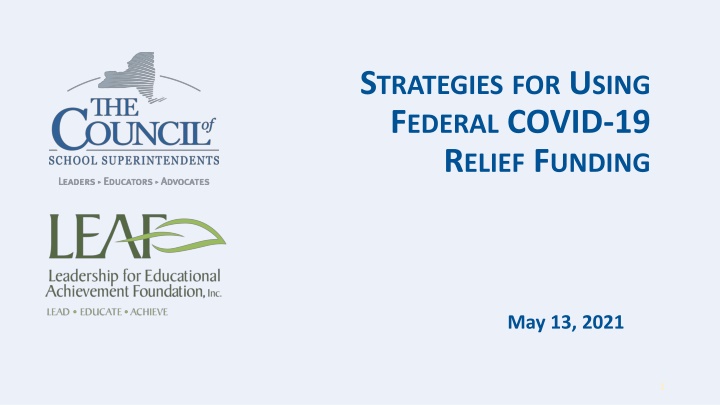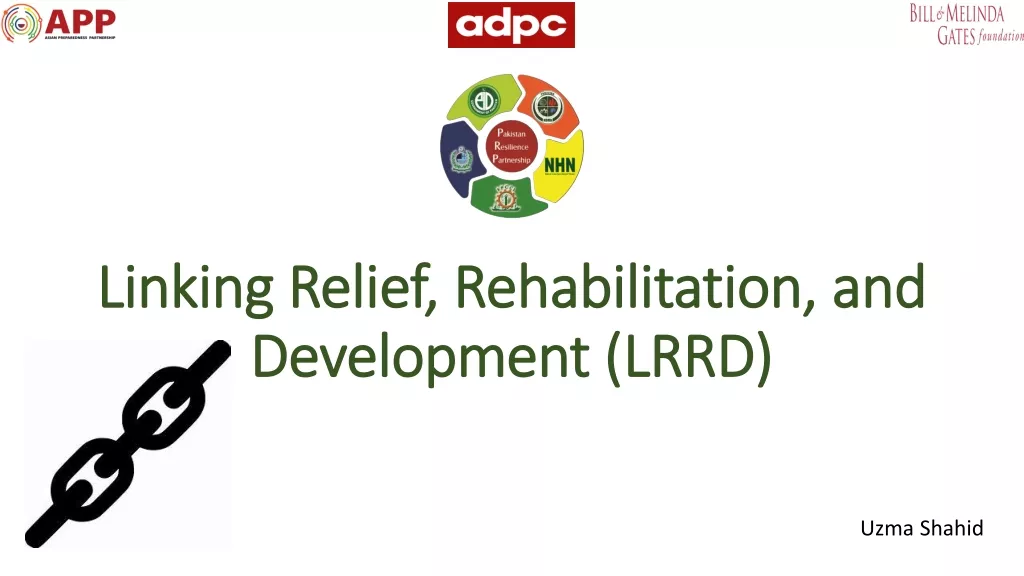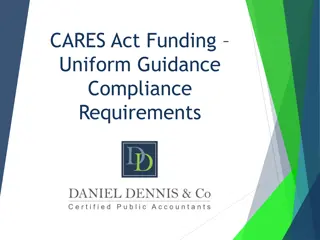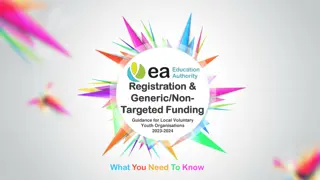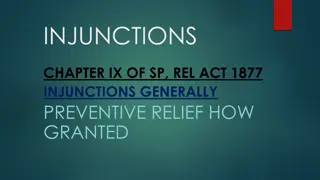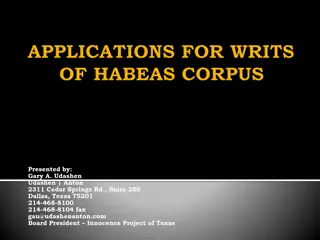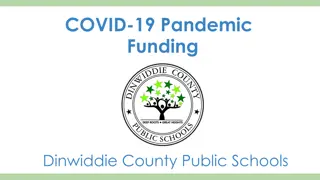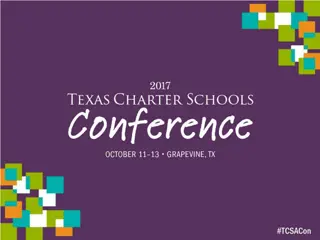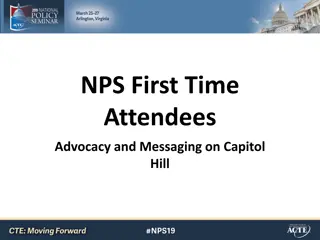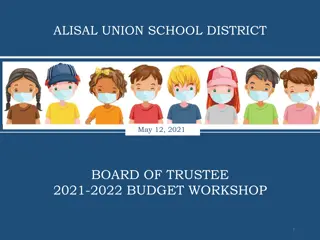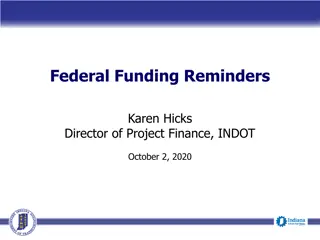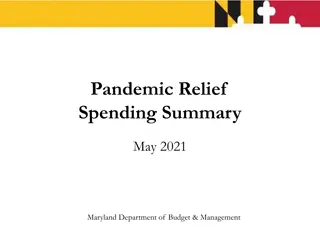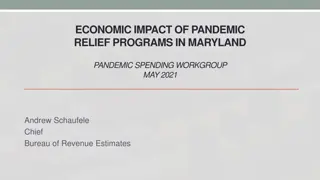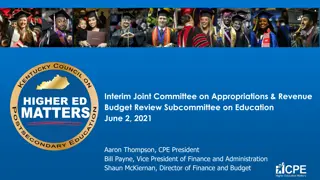Strategies for Using Federal COVID-19 Relief Funding - May 13, 2021
Federal COVID Relief Aid including allocation details from CRRSAA and ARPA, key points to note, application deadlines, and funding distribution strategies for education in New York. Learn more about maximizing and utilizing these relief funds effectively.
Download Presentation

Please find below an Image/Link to download the presentation.
The content on the website is provided AS IS for your information and personal use only. It may not be sold, licensed, or shared on other websites without obtaining consent from the author.If you encounter any issues during the download, it is possible that the publisher has removed the file from their server.
You are allowed to download the files provided on this website for personal or commercial use, subject to the condition that they are used lawfully. All files are the property of their respective owners.
The content on the website is provided AS IS for your information and personal use only. It may not be sold, licensed, or shared on other websites without obtaining consent from the author.
E N D
Presentation Transcript
STRATEGIES FOR USING FEDERAL COVID-19 RELIEF FUNDING May 13, 2021 1
Federal COVID Relief Aid Federal COVID Relief Aid Coronavirus Response and Relief Supplemental Appropriations Act (CRRSAA), enacted in December 2020: $4 billion allocated among school districts and charter schools from Elementary and Secondary School Emergency Relief Fund (ESSER 2)* $73 million Governor s Emergency Education Fund (GEER 2) allocated by state-created formulas American Rescue Plan Act (ARPA), enacted in March 2021 $8.09 billion allocated among school districts and charter schools from Elementary and Secondary School Emergency Relief Fund (ESSER 3)* $629 million allocated as Learning Loss Grants satisfies federal requirements $210 million to be used over multiple years for full-day prekindergarten expansion Additional funding provided for homeless student services, IDEA, internet access * By federal law, at least 90% of ESSER 2 and ESSER 3 funds must be allocated based on Title 1 shares 2
Some key points: Some key points: It s a lot of money equivalent to 12% of total general fund expenditures for a typical district. It s not permanent: CRRSAA: Districts must obligate by September 30, 2023 ARPA: Districts must obligate by September 30, 2024 Have more time to fully expend funds It comes with strings attached. 3
CRRSAA and ARPA applications CRRSAA and ARPA applications The State Education Department: opened the application portal for CRRSAA funding on Monday (May 10) applications due by June 15. provided information on applying for ARPA ESSER 3 funds on Wednesday (May 12) districts are to submit signed assurances by no later than May 24. The U.S. Education Department has indicated that it will be publishing further guidance on allowable uses of both CRRSAA and ARPA funding; SED will pass on that guidance upon receipt. 4
ARPA Funding ARPA Funding New York is receiving $8.98 billion in ARPA funding for education (ESSER 3) At least 90% must be allocated among school districts and charter schools based on shares of Title 1 funding ($8.09 billion). By federal law, districts are required to use at least 20% of these allocations to address learning loss. With the remaining 10%, states are required to reserve at least 5% to address learning loss, at least 1% for summer enrichment, and at least 1% for after school programs. The enacted state budget creates Learning Loss Grants to satisfy these federal reservation requirements. 5
https://www.nyscoss.org/nyscossdocs/Advocacy2021/2105_Federal_Allocations.xlsxhttps://www.nyscoss.org/nyscossdocs/Advocacy2021/2105_Federal_Allocations.xlsx Summary of Federal COVID-Relief Allocations to School Districts Coronavirus Response and Relief Supplemental Appropriations Act (CRRSAA) American Rescue Plan Act (ARPA) ARPA ESSER 3 Allocations Based on Title 1 Shares 2021-22 Enacted State Budget Allocations ("Learning Loss Grants") 2021-22 Enacted State Budget Allocations TotalARPA ESSER 3 Allocation Total CRRSAA Allocations Total ARPA ESSER 3 Allocation Based on Title 1 Minimum (20%) Required Set- Aside to Address "Learning Loss" 1% 1% CRRSAA ESSER 2 Allocation Based on Title 1 Shares Maximum Available for State-Level Reserve for Summer Enrichment State-Level Reserve for After School Programs 5% State-Level Reserves Total CRRSAA ESSER 2 Discretionary Allocation State-Level Reserve for "Learning Loss" CRRSAA GEER 2 Allocation Other District Albany City SD Berne-Knox-Westerlo CSD Bethlehem CSD Cohoes City SD Green Island UFSD Guilderland CSD Menands UFSD North Colonie CSD Ravena-Coeymans-Selkirk CSD South Colonie CSD Voorheesville CSD Watervliet City SD Grant Shares Allowable Uses $13,991,256 $356,309 $519,376 $1,952,505 $262,406 $934,086 $356,627 $1,623,015 $853,692 $1,788,788 $125,619 $1,347,424 $0 $0 $13,991,256 $730,695 $4,161,908 $2,004,351 $305,757 $4,995,503 $406,600 $5,667,835 $1,763,812 $4,598,207 $1,147,693 $1,418,043 $31,422,374 $800,219 $1,166,445 $4,385,049 $589,327 $2,097,824 $800,934 $3,645,061 $1,917,272 $4,017,365 $282,124 $3,026,123 $6,284,475 $160,044 $233,289 $877,010 $117,865 $419,565 $160,187 $729,012 $383,454 $803,473 $56,425 $605,225 $25,137,899 $640,176 $933,156 $3,508,039 $471,461 $1,678,259 $640,747 $2,916,049 $1,533,817 $3,213,892 $225,699 $2,420,899 $182,630 $112,073 $100,002 $100,002 $182,630 $112,073 $100,002 $100,002 $913,121 $560,351 $499,996 $499,996 $1,278,381 $784,497 $700,000 $700,000 $32,700,755 $1,584,716 $1,866,445 $5,085,049 $589,327 $2,797,824 $800,934 $3,645,061 $2,883,352 $4,717,365 $282,124 $4,656,252 $316,156 $3,075,995 $43,781 $36,607 $3,429,730 $42,199 $3,415,713 $768,565 $2,372,459 $863,106 $59,635 $58,229 $566,535 $8,063 $6,742 $631,686 $7,772 $629,105 $141,554 $436,958 $158,966 $10,983 $0 $0 $0 $0 $100,002 $100,002 $499,996 $700,000 $0 $0 $0 $0 $0 $0 $0 $0 $138,014 $100,002 $138,014 $100,002 $690,052 $499,996 $966,080 $700,000 $0 $0 $0 $0 $232,880 $232,880 $1,164,369 $1,630,129 6
This is included in our compilation of laws and regulations see slide 13 7
Another aspect of ARPA funding Another aspect of ARPA funding ARPA ARPA Title 1 Allocations Learning Loss Grants Total CRRSAA Federal Aid New York State 3,823,661,296 7,536,758,831 629,214,300 11,989,634,427 New York City (High Need) 2,135,039,120 4,794,994,577 - 6,930,033,698 Big 4 Cities (High Need) 256,304,126 575,622,659 4,315,222 836,242,007 High Need Small Cities & Suburbs 366,081,644 784,499,932 142,927,967 1,293,509,542 High Need Rural 173,148,265 381,284,716 144,548,039 698,981,020 Average Need 683,216,191 854,052,231 316,032,090 1,853,300,512 Low Need 209,871,949 146,304,717 21,390,982 377,567,648 SOURCE: Compiled by NYSCOSS from NYSED School Aid data 8
The state budget requires districts to develop a multi The state budget requires districts to develop a multi- -year plan for use of ARPA funding ARPA funding year plan for use of 9-a. On or before July 1, 2021, every local educational agency receiving funding from the elementary and secondary school emergency relief fund allocated by the American rescue plan act of 2021 shall be required to post on its websitea plan by school year of how such funds will be expended and how the local educational agency will prioritize spending on non-recurring expenses in the areas of: safely returning students to in-person instruction; maximizing in-person instruction time; operating schools and meeting the needs of students; purchasing educational technology; addressing the impacts of the COVID-19 pandemic on students, including the impacts of interrupted instruction and learning loss and the impacts on low- income students, children with disabilities, English language learners, and students experiencing homelessness; implementing evidence-based strategies to meet students' social, emotional, mental health, and academic needs; offering evidence-based summer, afterschool, and other extended learning and enrichment programs; supporting early childhood education. Provided further, that local educational agencies shall identify any programs utilizing such funding that are expected to continue beyond the availability of such federal funds and identify local funds that will be used to maintain such programs in order to minimize disruption to core academic and other school programs. Before posting such plan, the local educational agency shall seek public comment from parents, teachers and other stakeholders on the plan and take such comments into account in the development of the plan. Recent federal regulations also require district plans. Correction from the original presentation: SED will not merge the state budget and federal plan requirements. 9
State State- -prescribed timeline for using ARPA ESSER funds prescribed timeline for using ARPA ESSER funds State budget requires districts to reserve at least 50% of ARPA allocations based on Title 1 shares and spend: Not less than 12.5%* from the remaining half for each year between 2021-22 and 2024-25 Not more than 62.5% in any one of those years (i.e., the 50% reserve + 12.5%* annual minimum) Not applicable to about 100 districts with allocations equal to less than $500/pupil. Does not apply to Learning Loss Grants This requirement appears to be inconsistent with federal law. * The minimum annual percentage would rise to 18.75% for 2022-23 and 2023-24, if, by March 15, 2022, the federal government does not extend deadline for obligating funds to at least the end of the 2024-25 school year. 10
Fiscal Cliffs Fiscal Cliffs Federal Education Funding Federal Education Funding Governor s Proposed Enacted Budget Budget Total use of federal funds in 2021-22 to support recurring state costs $3.85 billion $140 million Use of federal funds specifically to offset reductions in state support $2.05 billion $35 million Enacted state budget: Federal allocations not included in annual aid totals on School Aid runs (except ($105 million for full-day prekindergarten expansion) CRRSAA and ARPA funds deemed grants in aid and to be reported in the special aid fund State budget requirements for district ARPA plans call for prioritizing non-recurring expenditures 11
Fiscal Cliffs Fiscal Cliffs Overall State Budget Overall State Budget Full phase-in of Foundation Aid promised projected $4+ billion increase by 2023-24 Overall budget uses over $12.6 billion in temporary ARPA unrestricted fiscal relief ($5.5 billion to be used in 2021-22) Business and personal income tax increases are projected to raise over $4 billion annually helps pay for Foundation Aid. But increases are scheduled to expire by end of 2027 (or earlier) this will be only partly offset by growing revenue from mobile sports betting and marijuana legalization Risks: Possible negative effects of tax increases personal income tax increases affect only 1% of taxpayers, but they represent 32% of total liability and over half are part-time state residents. Supreme Court case challenging authority of states to tax income of now fully remote workers residing in other states (out-of-state residents accounted for 16.6% of New York State personal income tax liability in 2018). How will New York City s economy fare? 12
Some Resources (live links) Some Resources (live links) Compilation of federal and state statutory and regulatory requirements: Allowable uses of CRRSAA and ARPA funding Requirements for set-asides (learning loss, summer enrichment, after school) State and federal requirements for district plans for using funds District safe-reopening plans required by federal law. District allocations, including required set-aside amounts NYSED memo on CRRSAA and ARPA allocations 13
Another learning opportunity: Another learning opportunity: State Education Department representatives will be part of a webinar sponsored jointly by the New York State School Boards Association, the Association School Business Officials New York, the Conference of Big 5 School Districts, and the Council. 12 Noon, Tuesday, May 18 Register here: https://register.gotowebinar.com/register/1980541913691241995 14
